[ENG//ESP] VERY INTERESTING THINGS THAT I HAVE LEARNED FROM PRE COLOMBINAN HISTORY // COSAS MUY INTERESANTES QUE HE APRENDIDO DE LA HISTORIA PRE COLOMBINA
Hello dear friends of Steemit:
Hola apreciados amigos de Steemit:
Reviewing some class sessions today I remembered something that for some time generated a lot of passion for me; Today I want to tell you about pre-Columbian history and some things that by investigating and scrutinizing I could discover for myself but that Peruvian popular history does not teach.
Revisando hoy algunas sesiones de clase recordé algo que por algún tiempo me genero bastante pasión; hoy deseo hablarles de historia pre-colombina y algunas cosas que indagando y escudriñando pude descubrir por mi mismo pero que la historia popular peruana no enseña.
Today I will talk about the empire of the Incas:
Hoy les hablare del imperio de los Incas:
Generally, most of the people in the world tend to think that when we are told about the empire of the Incas, that was the true name of the empire, it is not a secret for anyone that although there have been and still are many indigenous groups throughout the continent American, when we studied World History in high school there was only an emphasis on the three main groups of the pre-Columbian era. These were:
Generalmente la mayoría de las personas en el mundo tendemos a pensar que cuando se nos habla del imperio de los Incas era ese el nombre verdadero del imperio, no es un secreto para ninguno que aunque han habido y aun hay muchos grupos indígenas en todo el continente americano, cuando estudiábamos Historia Universal en la secundaria solo se hacia énfasis en los tres grupos principales de la era pre-colombina.! Estos eran:
*INCAS
*MAYAS y
*AZTECAS
However, I imagine that for reasons of time and in order to comply with an established class schedule, these subjects were always given the depth of a puddle of light rain.
Sin embargo, me imagino que por razones de tiempo y a fin de cumplir con un programa de clases establecido, siempre se le dio a estos temas la profundidad de un charco de lluvia ligera.
The truth is that only the sovereign and king who reigned at the time was called INCA or INKA, since he was considered a person of divine origin, a direct son of the great sun God whom they called INTI.
Lo cierto es que solo el soberano y rey que reinaba en su momento era llamado INCA o INKA, ya que se le tenia como una persona de origen divino, hijo directo del gran Dios sol a quienes llamaban INTI.
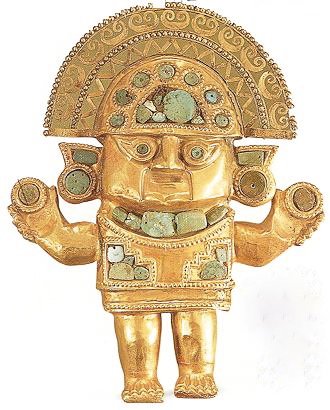
Fuente
El dios INTI
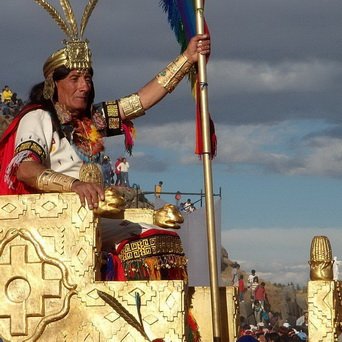
Fuente
El rey INCA
The vast people that this illustrious person ruled over the centuries was also called by that name, "The people of the Incas" ..! However, the correct name of the empire was: "The empire of Tahuantinsuyo" which in its ancestral language (Quechua) meant "* The four parts of the empire " or " The four parts of the world *", as this is a compound word :
Al extenso pueblo que gobernaba esta ilustre persona con el transcurrir de los siglos se le llamo también por ese nombre, "El pueblo de los Incas"..! Sin embargo el nombre correcto del imperio era: " El imperio del Tahuantinsuyo" que en su idioma ancestral (quechua) significaba "Las cuatro partes del imperio" o "Las cuatro partes del mundo", al ser esta una palabra compuesta:
*Tahua = Cuatro
*Suyo = Tierra o región
This Tahuantinsuyo was the most extensive and progressive kingdom of the entire American continent in pre-Columbian times as its name indicated, its territory was divided into four parts, these were:
Este Tahuantinsuyo fue el reino mas extenso y progresista d e todo el continente americano en la época precolombina tal como lo indicaba su nombre, su territorio estaba dividido en cuatro partes, estos eran:
*Contisuyo
*Chinchaysuyo
*Antisuyo y
*Collasuyo
CHINCHAYSUYO: It was the territory that covered from the southern part of Colombia, all of Ecuador and half of Peru.
CHINCHAYSUYO: Era el territorio que abarcaba desde la parte sur de Colombia, todo Ecuador y la mitad de Perú.
CONTISUYO: It was a small coastal region in the center of Peru and in front of the great Pacific Ocean which was known
symbolically as the region of the jaguar.
CONTISUYO: Era una pequeña región costera en el centro de Perú y frente al gran Océano Pacifico la cual se le conocía simbólicamente como la región del jaguar.
ANTISUYO: It was a thin but long strip of land that spanned the Andes mountain range from Ecuador, Peru and Bolivia; Where was the capital of the empire, which was called until today "Cuzco" that In his native language "Quechua" means "The navel of the world".
ANTISUYO: Era una delgada pero larga franja de terreno que abarcaba la cordillera de los Andes desde Ecuador, Perú y se encontraba la capital del imperio, la cual llevaba por nombre hasta hoy en día "Cuzco" que en su idioma natal "quechua" significa "El ombligo del mundo".
COLLASUYO: Together with Chinchaysuyo, it was the second largest part of the Tahuantinsuyo empire, which was It originated in Cuzco in central Peru and covered 90% of present-day Chile and the northern part of Argentina.
COLLASUYO: Era unto con Chinchaysuyo la segunda parte mas extensa del imperio del Tahuantinsuyo, la cual se originaba en Cuzco en el centro de Perú y abarcaba el 50% de la actual Chile y la parte norte de Argentina.
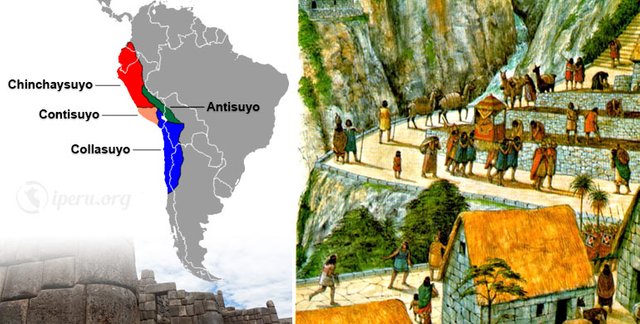
Fuente
EL TAHUANTINSUYO
These four regions of the Tahuantinsuyo are also known by the name of the four suyos or the four parts of the earth.
A estas cuatro regiones del Tahuantinsuyo se le conoce también con el nombre de los cuatro suyos o las cuatro partes de la tierra.
According to contemporary history only 13 of these INCAS or kings, regents and sovereigns are mentioned, they are divided by history into 3 groups which I name below:
Según la historia contemporánea solo se mencionan 13 de estos INCAS o reyes, regentes y soberanos, están divididos por la historia en 3 grupos los cuales nombro a continuación:
** The Legendary Empire **: Named for the way in which information was transmitted from generation to generation since the Inca culture did not have a form of writing, its history was carried by word of mouth through the years.
El Imperio Legendario: Llamado así por la forma en que se transmitió la información de generación en generación pues al no tener la cultura incaica una forma de escritura, su historia era llevada de boca en boca a través de los años.
In this first part of the history of the INCAS rulers we find only eight (8) of them, which I name below with their place and approximate date of death according to the narratives of their posterities:
En esta primera parte de la historia de los gobernantes INCAS encontramos solo a ocho (8) de ellos, los cuales nombro a continuación con su lugar y fecha aproximada de muerte según las narraciones de sus posteridades:
-Manco Capac: 1230 Muerte - Cuzco
-Sinchi Roca: 1260 Muerte - Cuzco
-Lloque Yupanqui: 1290 Muerte - Cuzco
-Mayta Capac: 1320 Muerte - Cuzco
Tarco Huaman: ? Muerte -
-Capac Yupanqui: 1350 Muerte - Cuzco
-Inca Roca: 1380 Muerte - Cuzco
-Yahuar Huacac: 1410 Muerte - Cuzco
-Viracocha Inca: 1438 Muerte - Cuzco
Inca Urco: 1438 Muerte -?
- Tarco Huaman * He was the favorite son of INCA Mayta Capac and began his reign after the death of his father, but a few weeks after assuming the Inca Empire he was overthrown by his cousin Capac Yupanqui, who after dethroning him reigned in his place, For this reason, Tarco Huaman is not mentioned as one of the Inca nobles, although the truth is that he was.
Tarco Huaman Fue el hijo predilecto del INCA Mayta Capac y comenzó su reinado después de la muerte de su padre, pero a pocas semanas de haber asumido el Incanato fue derrocado por su primo Capac Yupanqui, quien después de destronarlo reinó en su lugar, por tal razón no se menciona a Tarco Huaman como uno de los nobles Incas aunque lo cierto es que si lo fue.
- Inca Urco * He was the preferred son of Viracocha Inca and was according to the chroniclers the worst ruler that the Inca empire had, because not only was he an alcoholic and promiscuous and fornicator, but he was a liar and immoral behavior, for this reason he was assassinated and his name was erased from the list of the rulers of Tahuantinsuyo, involuntarily giving place in history to INCA Pachacutec.
Inca Urco Fue el hijo preferido de Viracocha Inca y fue según los cronistas el peor gobernante que tuvo el imperio incaico, pues no solo era alcohólico y promiscuo y fornicador, sino que era mentiroso y de comportamiento inmoral, por tal motivo fue asesinado y su nombre fue borrado de la lista de los gobernantes del Tahuantinsuyo, cediendo lugar en la historia Involuntariamente al INCA Pachacutec.
** The Historical Empire **: At this time in the history of the Tahuantinsuyo empire they still did not have writing but they had found a way to record the events that occurred by carving in stone, and it was made up of six (6) sovereign INCAS, including his year and place of death:
El Imperio Histórico: En esta época de la historia del imperio del Tahuantinsuyo aun no tenían escritura pero habían encontrado la forma de registrar los acontecimientos ocurridos mediante el tallado en piedra , y estuvo conformado por seis (6) INCAS soberanos, incluidos su año y lugar de muerte:
-Pachacutec 1471 Muerte - Cuzco
-Tupac Yupanqui 1493 Muerte – Distrito de Chinchero
-Huayna Capac 1527 Muerte - Colombia
Ninan Cuyuchi 1527 Muerte - Ecuador
-Huascar 1533 Muerte – Andamarca - Perú
-Atahualpa 1533 Muerte - Cajamarca
- Ninan Cuyuchi *: The story of the almost INCA Ninan Cuyuchi is in particular one of the ones that causes me the most reflection because at this time very important things were happening in parallel:
Ninan Cuyuchi: La historia del casi INCA Ninan Cuyuchi es en particular una de las que mas reflexión me causa debido a que en este tiempo estaban pasando cosas muy importantes de forma paralela:
- As you already know, Christopher Columbus had reached the American continent for the first time in the year 1492, arriving for the first time in Central America, after that first trip he made two more until his death in the year 1506.
- Como ustedes ya saben, Cristóbal Colon había llegado al continente americano por primera vez en el año de 1492, llegando por primera vez a Centro América, luego de ese primer viaje realizo realizo dos mas hasta su muerte en el año de 1506.
By the year 1525, with the maritime route already mapped, expeditions of exploration and conquest began to arrive, bringing with them great advances but also great tragedies in the form of massacres, deforestation and diseases that are already common in Europe. but unknown in this new land.
Ya para el año de 1525, con la ruta marítima ya cartografiada, comenzaron a llegar las expediciones de exploración y conquista, trayendo con ellos a este nuevo continente grandes avances pero también grandes tragedias en forma de matanzas, deforestación y enfermedades ya comunes en Europa, pero desconocidas en este nueva tierra.
Many conquerors arrived in those years, among them I will name Hernan Cortez, who is credited with the conquest and destruction of the Aztec Empire in the center and north of this great new continent, and Francisco Pizarro, who is credited with the conquest and destruction of the Inca Empire. .
Llegaron muchos conquistadores en esos años, entre ellos nombrare a Hernan Cortez a quien se le atribuye la conquista y destrucción del Imperio Azteca al Centro y norte de este gran nuevo continente, y Francisco Pizarro a quien se le atribuye la conquista y destrucción del Imperio Incaico.
- The great INCA Huayna Capac was focused on the expansion of the already extensive Tahuantinsuyo empire and was already in Colombian territory consolidating the foundations of the great kingdom, when suddenly he ran into an unknown disease for which there was no known cure. which caused his death, it is commonly believed that this unknown disease is what we know today by the name of smallpox.
- El gran INCA Huayna Capac estaba enfocado en la expansión del ya bien extenso imperio del Tahuantinsuyo y se encontraba ya en territorio colombiano consolidando las bases del gran reino, cuando de repente se topó con una enfermedad desconocida para la cual no se conocía cura, la cual le causo la muerte, comúnmente se cree que esta enfermedad desconocida es la que hoy en día conocemos con el nombre de viruela.
The great INCA, seeing the end of his life near, appointed his favorite son named Ninan Cuyuchi as his successor before the priests, who was in Ecuador, but when the priests went to meet the new future INCA, they found that he too he had died several days before his father of the same unknown disease.
El gran INCA viendo cerca el final de su vida designo como su sucesor ante los sacerdotes a su hijo predilecto llamado Ninan Cuyuchi, el cual se encontraba en Ecuador, pero cuando los sacerdotes fueron al encuentro del nuevo futuro INCA, se encontraron con que el también había muerto varios días antes que su padre de la misma enfermedad desconocida.
It was then when the Coya (INCA's wife) promoted the calling of his son Huascar as the new INCA in charge of the entire Tahuantinsuyo empire, but after a year of reign he was overthrown and assassinated by his brother Atahualpa who replaced him in the monarchical seat as the new INCA without knowing that just a few weeks later and in 1532 it would be visited by a strange foreign visitor dressed in metallic armor accompanied by just a few dozen soldiers, who carried with them the secret of the mass destruction called gunpowder that at that time the tenacious warriors of INCA did not know.
Fue entonces cuando la Coya (La esposa del INCA) promovió el llamamiento de su hijo Huascar como nuevo INCA a cargo de todo el imperio del Tahuantinsuyo, pero que después de un año de reinado fue derrocado y asesinado por su hermano Atahualpa quien lo sustituyó en el asiento monárquico como nuevo INCA sin saber que a tan solo pocas semanas después ya en 1532 seria visitado por un extraño visitante extranjero vestido de armadura metálica acompañado de apenas unas cuantas decenas de soldados, los cuales llevaban con ellos el secreto de la destrucción masiva llamada pólvora que para ese momento los tenaces guerreros del INCA no conocían.
This strange visitor turned out to be Francisco Pizarro, who a few days after his arrival and meeting with the one who would be the last INCA by royal inheritance, in which today is the city of Cajamarca, decided to attack the INCA town ending with his royal army and Sowing death among them, he captured the INCA and held him captive for the space of a year while he made sure to obtain all the gold and silver possible as ransom in exchange for the monarch's freedom and that finally when he obtained as much gold as he wanted, he decided to kill the INCA youth on July 26, 1533.
Este extraño visitante resulto ser Francisco Pizarro el cual a pocos días de su llegada y encuentro con el que seria el ultimo INCA por herencia real, en la que hoy es la ciudad de Cajamarca, decidió atacar al pueblo del INCA acabando con su ejercito real y sembrando la muerte entre ellos, capturo al INCA y lo mantuvo cautivo por el espacio de un año mientras se aseguro obtener todo el oro y plata posible como rescate a cambio de la libertad del monarca y que finalmente cundo obtuvo tanto oro como quiso decidió matar al joven INCA el 26 de julio de 1533.
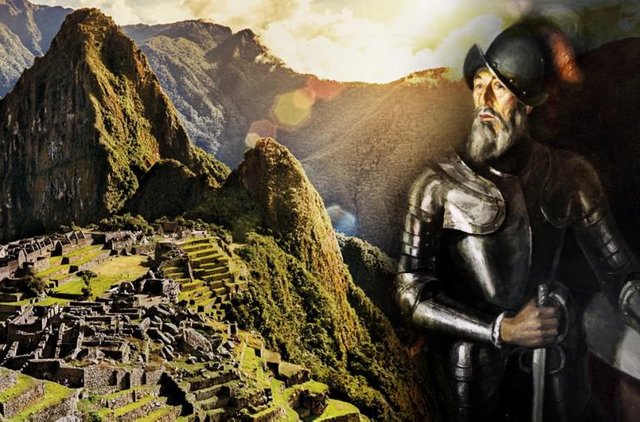
Fuente
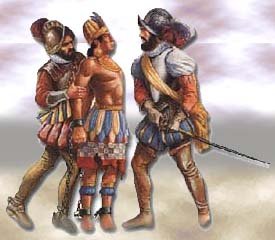
Fuente
Captura de Atahualpa
After this he decided to place another INCA ruler imposed by him and whom he could manage and chose for this one of the younger brothers of the deceased INCA to try to appease the anger and frustration of the people.
Luego de esto decidió colocar otro gobernante INCA impuesto por el y al cual pudiese manejar y escogió para esto a uno de los hermanos menores del INCA fallecido para tratar de apaciguar la ira y frustración del pueblo.
** Incas de Vilcabamba **: From this point on, the few descendants of the ancient INCAS decided to mount a resistance, but as they could not compete with the armies or Spanish arms, they therefore decided to decline Cuzco as a place of the central government. and they took refuge in the mountains of Vilcabamba, thus giving rise to a new but last stage of the Incan, these are the INCAS that made it up, including their dates and place of death:
Incas de Vilcabamba: Ya a partir de este punto los pocos descendientes de los antiguos INCAS decidieron armar una resistencia, pero como no podían competir con los ejércitos ni con las armas españolas, decidieron por tanto declinar Cuzco como lugar del gobierno central y se refugiaron en las montañas de Vilcabamba, dando origen así a una nueva pero ultima etapa del incanato, estos son los INCAS que lo conformaron incluyendo sus fechas y lugar de muerte:
Tupac Hualpa 1533 Muerte - Jauja
-Manco Inca 1545 Muerte – Montañas de Vilcabamba
-Sayri Tupac Inca 1561 Muerte – Montañas de Vilcabamba
-Titu Cusi Yupanqui 1570 Muerte – Montañas de Vilcabamba
-Tupac Amaru 1ero 1572 Muerte – Cuzco
- Tupac Hualpa * Better known as "Toparpa" ..! He was one of the younger brothers of the deceased INCA Atahualpa who was placed in the Inca seat by design of Francisco Pizarro, at first the young INCA tried to preserve peace and neutrality between both peoples (Incas and Spaniards), this was very bad seen by the already quite humiliated people of Tahuantinsuyo, therefore they decided not to recognize him as their leader, seeing this, added to the injustices and mistreatments that the Spaniards gave the people, the young INCA decided to reveal himself in favor of the people, but before he could take the control of and recognition of its town was poisoned by the Spanish.
Tupac Hualpa Mejor conocido como "Toparpa"..! Era uno de los hermanos menores del INCA fallecido Atahualpa el cual fue puesto en el asiento incaico por designio de Francisco Pizarro, al principio el oven INCA trato de conservar la paz y la neutralidad entre ambos pueblos (Incas y españoles), esto fue muy mal visto por el ya bastante humillado pueblo del Tahuantinsuyo por tanto decidieron no reconocerlo como su líder, al ver esto, sumado a las injusticias y maltratos que los españoles propinaban al pueblo el oven INCA decidió revelarse en favor del pueblo, pero antes de que pudiese tomar el control de y reconocimiento de su pueblo fue envenenado por los españoles.
** Data for reflection **: The Spanish conqueror Francisco Pizarro ended the glory of the Inca empire in 1933 by killing the Inca king Atahualpa and only 13 years before, in 1520 Moctezuma king of the Aztecs would die, thus causing a serious crisis and the fall of the powerful Aztec empire under the responsibility of the Spanish conqueror Hernan Cortés.
Datos de reflexión: El conquistador español Francisco Pizarro acabo con la gloria del imperio incaico en 1933 matando al rey inca Atahualpa y solo 13 años antes, en 1520 fallecería Moctezuma rey de los Aztecas ocasionando así una grave crisis y la caída del poderoso imperio Azteca bao la responsabilidad del conquistador español Hernan Cortés.
How many great events in such a short time have disregarded the future of our continent, many of these pre-Columbian cultures were experts in astronomy, meteorology and mathematics .. !! The other was an expert in building large buildings .. !! Can you imagine how much scientific knowledge was lost during the colonization process?
Cuantos eventos magnos en tan corto tiempo desdieron el futuro de nuestro continente, muchas de estas culturas pre-colombinas eran expertos en astronomía, meteorología y matemáticas..!! La otra era experta en edificación de edificios de gran magnitud..!! Se imaginan cuanto conocimiento científico se perdió durante el proceso de colonización..?
Well dear friends of Steemit, I hope you enjoy the story as much as I do .. !! I also hope that this small cultural contribution has been of help to your intellects.
Bueno apreciados amigos de Steemit, espero que disfruten tanto la historia como yo..!! También espero que este pequeño aporte cultural haya sido de ayuda para sus intelectos.
To learn more about this interesting topic you can visit my YouTube channel "Histografias" whose link I put here below.
Para aprender mas de este interesante tema pueden visitar mi canal de Youtube "Histografias" cuyo enlace les coloco aquí abajo.
Learn more about me here Achievement 1 My presentation
Conoce más sobre mi aquí Logro 1 Mi presentación
Saludos Cordiales a todos.